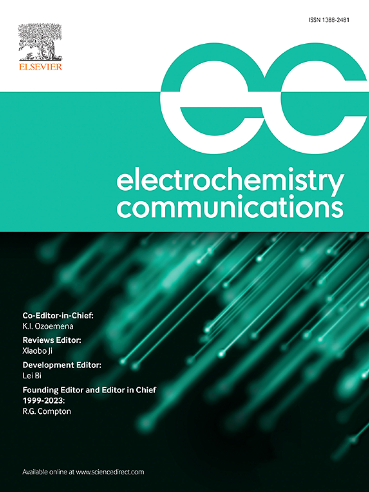Influence of lithium salt anions on the interfacial properties of PEO-based solid-state electrolytes
IF 4.2
3区 工程技术
Q2 ELECTROCHEMISTRY
引用次数: 0
Abstract
The use of poly(ethylene oxide) (PEO)-based solid-state electrolytes have shown potential to improve both the energy density and safety performance of lithium-metal batteries. However, these electrolytes often form unstable interfaces with lithium metal anodes, compromising the durability and sustained performance of solid-state lithium-metal batteries. In this study, three lithium salts, lithium (fluorosulfonyl) (trifluoromethanesulfonyl)imide (LiFTFSI), lithium bis(fluorosulfonyl)imide (LiFSI), and lithium bis(trifluoromethanesulfonyl)imide (LiTFSI), were each mixed in equimolar ratios with tetraethylene glycol dimethyl ether (G4) and introduced as a conductivity enhancer in PEO-based solid-state electrolytes. The effects of the lithium salt anions on the electrolyte properties were systematically investigated. Among the three, the fluorosulfonyl group was found to enhance ionic conductivity, while the trifluoromethanesulfonyl group improved thermal stability. Notably, the synergistic interaction between these two groups in LiFTFSI led to the formation of a stable solid-electrolyte interphase (SEI), characterized by a higher content of inorganic species and reduced organic components. As a result, LiFTFSI/G4-based solid-state electrolytes enabled stable cycling for 200 cycles at a 0.5C rate in LiFePO4-based solid-state lithium-metal batteries, achieving a capacity retention of 91 %. This study provides valuable insights into the optimization of high-efficiency solid-state lithium-metal batteries by elucidating the distinct roles of lithium salt anions.
锂盐阴离子对peo基固态电解质界面性能的影响
基于聚环氧乙烷(PEO)的固态电解质的使用已经显示出提高锂金属电池能量密度和安全性能的潜力。然而,这些电解质通常会与锂金属阳极形成不稳定的界面,从而影响固态锂金属电池的耐用性和持续性能。在这项研究中,三种锂盐,锂(氟磺酰基)(三氟甲烷磺酰基)亚胺(LiFTFSI),锂(氟磺酰基)亚胺(LiFSI)和锂(二氟甲烷磺酰基)亚胺(LiTFSI),分别与四乙二醇二甲醚(G4)以等摩尔的比例混合,并作为电导率增强剂引入peo基固态电解质中。系统地研究了锂盐阴离子对电解质性能的影响。其中,氟磺酰基可以增强离子电导率,而三氟甲磺酰基可以提高热稳定性。值得注意的是,在LiFTFSI中,这两组之间的协同作用导致了稳定的固体电解质界面(SEI)的形成,其特征是无机物质含量较高,有机成分减少。结果表明,基于LiFTFSI/ g4的固态电解质能够在0.5℃的温度下在基于lifepo4的固态锂金属电池中稳定循环200次,实现91%的容量保持。本研究通过阐明锂盐阴离子的不同作用,为高效固态锂金属电池的优化提供了有价值的见解。
本文章由计算机程序翻译,如有差异,请以英文原文为准。
求助全文
约1分钟内获得全文
求助全文
来源期刊

Electrochemistry Communications
工程技术-电化学
CiteScore
8.50
自引率
3.70%
发文量
160
审稿时长
1.2 months
期刊介绍:
Electrochemistry Communications is an open access journal providing fast dissemination of short communications, full communications and mini reviews covering the whole field of electrochemistry which merit urgent publication. Short communications are limited to a maximum of 20,000 characters (including spaces) while full communications and mini reviews are limited to 25,000 characters (including spaces). Supplementary information is permitted for full communications and mini reviews but not for short communications. We aim to be the fastest journal in electrochemistry for these types of papers.
 求助内容:
求助内容: 应助结果提醒方式:
应助结果提醒方式:


